Bulletin – September 2010 Durable Goods and the Business Cycle
- Download the article 218KB
Abstract
Spending on durable goods tends to be more cyclical than spending on non-durable goods and services as it can be more readily postponed in times of economic weakness. During the recent global economic slowdown, the decline in durable goods spending was a key transmission mechanism of the uncertainty associated with the global financial crisis to the broader economy, as households and businesses delayed purchases of durable goods.
Introduction
A notable feature of the recent global downturn was a significant fall in demand for consumer durables and capital goods. In part, this reflected a sharp rise in uncertainty associated with the financial crisis, which discouraged households and businesses from making purchases of durable goods until conditions were more certain. These developments highlight the dynamics of demand for durables as drivers of the business cycle.
Cycles in spending on durable goods, both consumer and business, have long been identified as an important feature of the business cycle. The academic literature has found that durable goods consumption spending in both Australia and the United States is highly correlated with total output and is significantly more volatile over the cycle than either total output or the consumption of non-durable goods and services.[1]
This article examines cycles in spending on durable goods in Australia over the past 50 years and during the recent economic slowdown, and provides a comparison with the United States and other economies. In addition, it discusses the relative importance of durable goods cycles for economies that are importers (net consumers) or exporters (net producers) of durables.
What are Durables?
Durable goods provide a stream of services or utility over time. In contrast, non-durable goods and services tend to be consumed immediately. In the case of consumers, examples of durable goods are motor vehicles and household furnishings; examples of non-durable goods and services include food and transport services.[2] As the services received from existing holdings of durable goods tend to be maintained even in the absence of any new purchases, spending on durables can be more easily deferred. For example, a household experiencing a fall in income may decide not to purchase a new car since it can continue to use its current car. As well as being able to be postponed, many durable goods can be considered discretionary compared with more essential spending like food. As a result of these two properties, consumer spending on durable goods is more volatile than spending on non-durable goods and services, and tends to be more closely related to the economic cycle.
Business investment is another example of deferrable durables spending which is also correlated with the business cycle. In the case of construction, firms are likely to delay any new projects going into a slowdown, but to complete projects that are already underway. In the case of machinery & equipment investment (such as motor vehicles and computers), firms are more likely to be able to change their investment plans rapidly in response to changes in economic conditions. Accordingly, in addition to consumer durables, this article focuses on the machinery & equipment component of business investment.
Cycles in Durable Goods Spending
A common method of looking at the cyclical properties of an economic variable is to calculate its correlation with GDP over the cycle. It is also common to examine the relative volatility of an economic variable by taking the ratio of its standard deviation to that of GDP growth.
Spending on consumer durable goods and machinery & equipment investment has been highly correlated with GDP growth in both Australia and the United States over the past 50 years. The variables are pro-cyclical, meaning they are positively correlated with output growth, with falls (increases) in spending on durables associated with periods of economic weakness (strength) (Table 1).[3] Household spending on non-durable goods and services is also positively correlated with GDP growth. In Australia, the correlation with the economic cycle is higher for household spending on durable items than for non-durable goods and services. This distinction is also apparent for the United States, albeit to a lesser extent.
| Durable goods consumption | Non-durable goods consumption |
Services consumption | Machinery & equipment investment | |
|---|---|---|---|---|
| Correlation with GDP(a) | ||||
| Australia | 0.63 | 0.20 | 0.34 | 0.50 |
| US | 0.79 | 0.75 | 0.67 | 0.82 |
| Volatility relative to GDP(b) | ||||
| Australia | 1.9 | 0.9 | 0.7 | 4.6 |
| US | 2.7 | 0.8 | 0.6 | 3.4 |
|
(a) The correlation coefficient shows how much two variables co-vary compared
to their standard deviations. It ranges between −1 and 1 (where 1 indicates
the series have proportional changes in the same direction) Sources: ABS; Bureau of Economic Analysis |
||||
The high correlations for durables spending and GDP growth appear to be mostly a result of episodes of weak economic activity.[4] This suggests that there is a greater association between falls in household spending on durables and falls in income than for increases in these variables. Similarly, the relationship between business investment and GDP growth is stronger during downturns. During deep recessions, spending on consumer durables and capital goods in Australia has fallen sharply (Table 2). In contrast, growth in household spending on non-durables and services slowed on average, but remained positive. The experience in the United States has been similar.
| GDP | Durable goods consumption | Non-durable goods consumption | Services consumption | Machinery & equipment investment | |
|---|---|---|---|---|---|
| Australia | −2.6 | −5.7 | 0.6 | 3.6 | −14.1 |
| US | −3.2 | −6.7 | −1.2 | 0.6 | −10.7 |
|
(a) Growth rates for each series calculated from GDP peak to trough in 1960–1961, 1981–1983 and 1990–1991 for Australia and in 1974–1975, 1981–1982 and 2008–2009 for the United States Sources: ABS; Bureau of Economic Analysis |
|||||
Consistent with earlier findings, updated data show that the volatility of durable goods spending and machinery & equipment investment is much higher than the volatility of spending on non-durable goods and services (Table 1). While durable goods consumption and machinery & equipment investment have declined (in year-ended terms) during periods of economic weakness in Australia and the United States since 1960, falls in spending on non-durables have been rare (Graph 1).
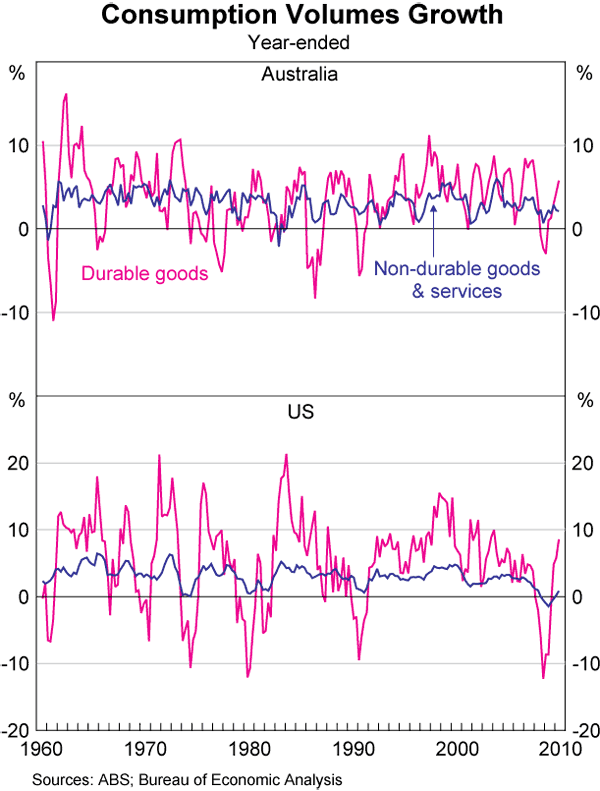
Durables Spending during the Recent Downturn
Historically, the cyclical pattern of durables spending often reflected households delaying purchases of durable goods in response to falls in income and firms deferring capital good purchases due to softening demand. However, the business cycle dynamics of durables during the recent period of economic weakness in 2008/09 appear to have been somewhat different. In this case, falls in consumer durables and capital goods spending in part provided a transmission mechanism of the uncertainty created by the financial crisis to the broader economy: uncertain financial conditions and concerns over the economic outlook caused consumers and businesses to become more cautious and postpone or scale back deferrable spending, which in turn had flow-on effects on the rest of the economy. Firms responded to the fall in demand for consumer durables and capital goods by sharply cutting production of such goods and this flowed through into international trade.
Globally, measures of consumer and business confidence fell in late 2007 and 2008 in an environment of increased uncertainty and higher risk aversion (Graph 2). Consistent with the pattern in the long-run data, spending on consumer durables fell more sharply than spending on non-durable goods and services (Graph 3). The decline in machinery & equipment investment was also a global phenomenon, partly reflecting the rise in uncertainty and firms responding to softer consumer demand. In some major economies such as Japan and the United States, machinery & equipment investment declined by 20 per cent or more from peak to trough.
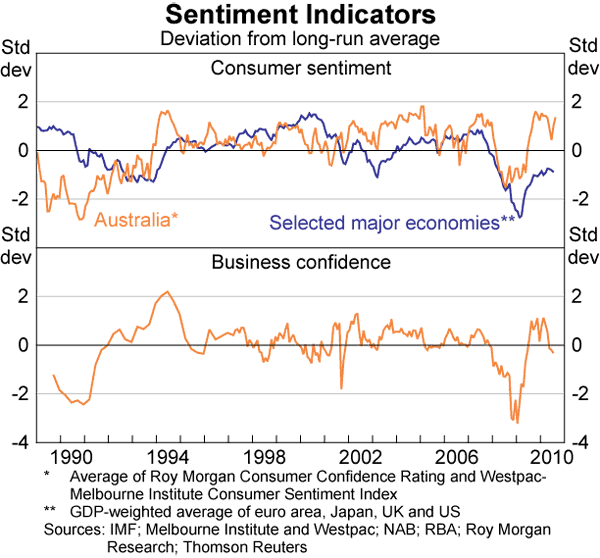
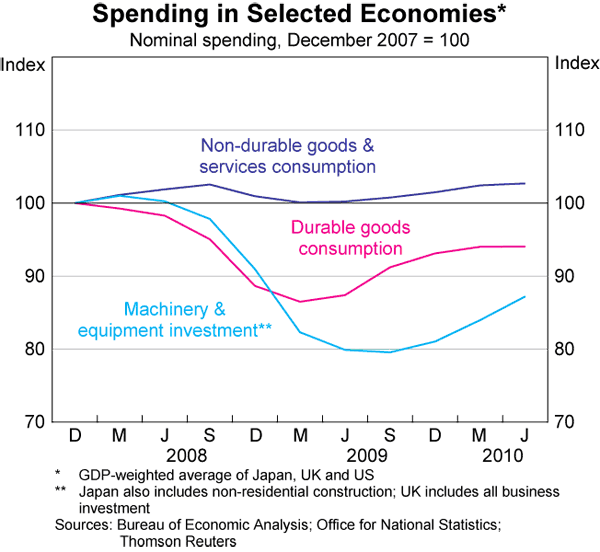
The falls in confidence also contributed to the decline in global industrial production that took place (Graph 4). In line with softer global demand for consumer durables and capital equipment, the largest declines in production were for these goods and there was a large contraction in world trade. Economies that are large producers and exporters of durable goods tended to be significantly affected by the sharp fall in durables spending. For example, exports from east Asia (excluding Japan and China) declined by around 20 per cent during 2008. In addition to uncertainty, tighter access to various forms of credit also seems to have been a factor in the declines in production and international trade.
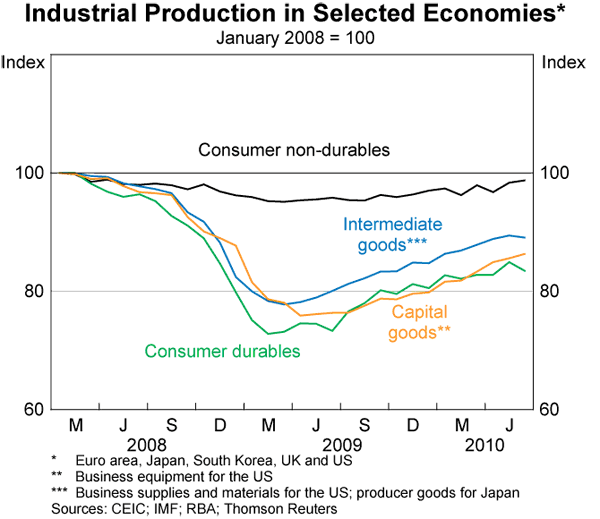
There has subsequently been some recovery in global durables demand, though spending on consumer durables and capital goods remains below the recent peak in many economies. Given the weakness in demand during the slowdown, governments in several countries introduced temporary subsidies targeted at spending on consumer durables. The effect of this was two-fold: it lowered the price of durables relative to non-durables; and it lowered the current price of durables relative to their future price. The second effect encouraged intertemporal substitution, with consumers choosing to buy goods immediately rather than wait; in many cases this resulted in spending that would otherwise have taken place in the future being brought forward. These types of subsidies were particularly evident in economies that are large producers of durables. Motor vehicle subsidies for consumers were introduced in a number of countries, including China, Japan, the United States and some European nations, with higher car sales and production reported in many cases.[5] In addition to government subsidies, firms in many countries offered discounts on durable goods, further lowering their relative price. In Japan, the government introduced subsidies for motor vehicles and energy efficient appliances and firms reduced prices significantly. Reflecting these factors, the recovery in durables spending has been especially rapid in Japan, with spending rising almost 20 per cent in nominal terms over the year following the trough recorded in the March quarter 2009.
International trade has also recovered somewhat, with this turnaround being most pronounced in east Asia where exports have retraced the previous sharp fall. Electronic components and consumer durables appear to have played a prominent role in driving the rebound. In Korea, for example, exports of motor vehicles and semi-conductors recovered strongly following sharp falls over the second half of 2008. Korean exports of motor vehicles benefited from car scrappage schemes in the United States and several European countries, although the increase in auto exports has been broad-based across destinations.
In Australia the declines in confidence during the financial crisis were sharp, but nevertheless shallower and less protracted than in many other advanced economies. In line with the less severe drop in consumer sentiment, the fall in Australian household spending on durable goods was smaller than in many other advanced economies (6 per cent versus an average of 15 per cent for Japan, the United Kingdom and the United States; Graph 5). As was the case globally, many Australian firms experienced difficult trading conditions and tight credit conditions, becoming more cautious with their spending and delaying or reducing investment plans. While machinery & equipment investment in Australia did not fall as sharply as in other advanced economies, it remains subdued.
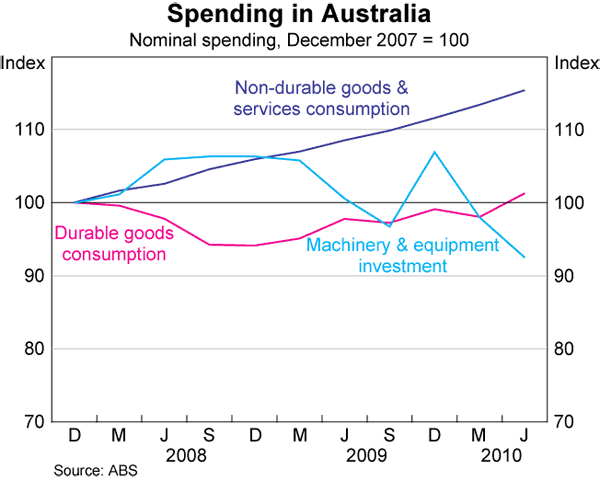
After falling over the first half of 2008, spending on consumer durables in Australia has experienced a rebound. As was the case in many economies, the Australian Government introduced measures to boost household spending. However, in contrast to the temporary subsidies for durable goods introduced overseas, the Australian measures were more general, providing a boost to household incomes through the cash payment component of the stimulus package. This may have reflected the fact that Australia produces few durable goods and is a large importer of these. The income boost did not change the price of durables relative to non-durables or relative to durables in the future. As a result, the effects were widespread; while many households increased spending on durables, others purchased non-durables or saved their cash bonus.
The Australian Government also introduced measures to support investment, with firms receiving temporary tax credits for investing in new tangible depreciating assets between 13 December 2008 and 31 December 2009. Machinery & equipment investment rose sharply in the December quarter 2009, ahead of the expiry of the tax deductions (Graph 6). Private-sector surveys suggest that the temporary reduction in the cost of investment goods induced about one third of small businesses to increase business spending. It appears that the temporary subsidy brought forward some investment, with a decline in machinery & equipment investment over the first half of 2010.
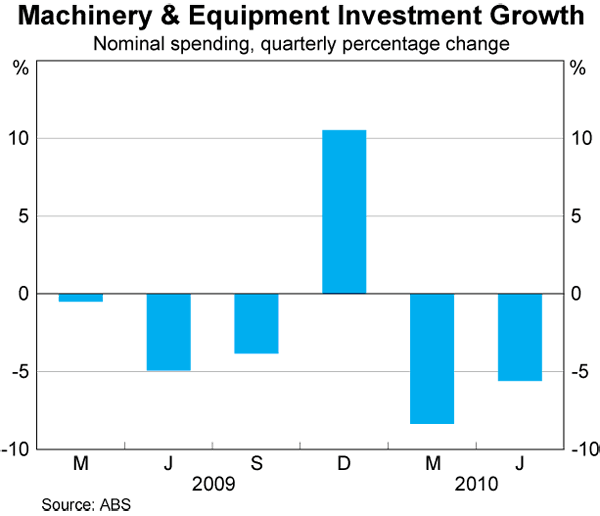
As Australia is a net importer of durables and capital goods, falls
in spending on consumer durables and capital goods tend to be partly offset
by falls in net imports of these types of goods
(Graph 7).[6]
Spending on consumer durables less imports is much less correlated with GDP
growth compared to durables spending
alone.[7]
Nonetheless, Australia is affected by the global durables cycle through other
channels, such as international demand for commodities that are used in the
process of manufacturing durables, and the wholesaling and retailing industries.
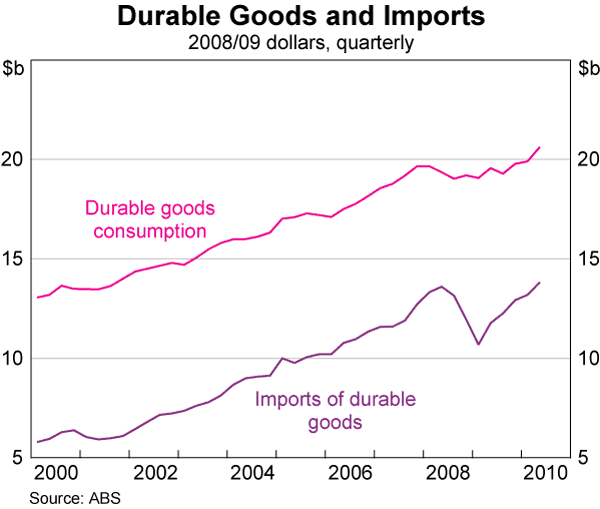
Appendix A: Consumer Spending Categories
| Consumption component | Type |
|---|---|
| Clothing & footwear | Durable good |
| Furnishings & household equipment | Durable good |
| Purchases of vehicles | Durable good |
| Food | Non-durable good |
| Cigarettes & tobacco | Non-durable good |
| Alcoholic beverages | Non-durable good |
| Electricity, gas & other fuels | Service |
| Rent & other dwelling services | Service |
| Health | Service |
| Operation of vehicles | Service |
| Transport services | Service |
| Communications | Service |
| Recreation & culture | Service |
| Education services | Service |
| Hotels, cafés & restaurants | Service |
| Insurance & other financial services | Service |
| Other goods & services | Service |
|
Source: RBA |
Footnotes
The authors are from Economic Analysis Department. [*]
See Fisher, Otto and Voss (1996), Luengo-Prado (2006) and Stock and Watson (1999). [1]
Around 15 per cent of household spending in Australia tends to be on durable goods. Table A1 shows the details of the household final consumption expenditure series used to construct the durable goods, non-durable goods and services series used in this article. [2]
The correlations are slightly lower when we exclude each component from GDP (i.e. durable spending and GDP excluding durable spending), but the conclusions regarding relative cyclicality are unchanged. [3]
The correlations fall significantly when the bottom decile of GDP growth outcomes are excluded, whereas excluding the top decile of GDP growth outturns has a much smaller effect on the correlation coefficients. [4]
In the United States, the government also introduced temporary incentives to encourage housing activity through home-buyer tax credits. [5]
See Downes, Louis and Lay (1994). [6]
The depreciation of the Australian dollar in 2008, which increased the price of imports, and its subsequent appreciation also contributed to the sharp fall and subsequent rise in the volume of imports of durable goods. [7]
References
Downes P, C Louis and C Lay (1994), ‘Influences on the Australian Business Cycle’, Paper presented to the 23rd Annual Conference of Economists, Economic Society of Australia.
Fisher L, G Otto and G Voss (1996),
‘Australian Business Cycle Facts’,
Australian Economic Papers, 35(67),
pp 300–320.
Luengo-Prado MJ (2006), ‘Durables, Nondurables, Down Payments and Consumption Excesses’, Journal of Monetary Economics, 53, pp 1509–1539
Stock JH and MW Watson (1999), ‘Business Cycle Fluctuations in US Macroeconomic Time Series,’ in JB Taylor and M Woodford (eds), Handbook of Macroeconomics, pp 3–64, Elsevier, Amsterdam.